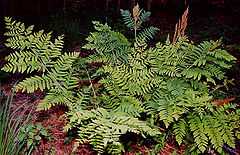Osmunda
| Osmunda Temporal range: Triassic–recent | |
|---|---|
 | |
| Osmunda regalis | |
| Scientific classification | |
| Kingdom: | Plantae |
| Division: | Pteridophyta |
| Class: | Polypodiopsida / Pteridopsida (disputed) |
| Order: | Osmundales |
| Family: | Osmundaceae |
| Genus: | Osmunda L. |
| Species | |
|
Osmunda japonica | |
Osmunda is a genus of primarily temperate-zone ferns of family Osmundaceae. Five to ten species have been listed for this genus.
The species have completely dimorphic fronds or pinnae (hemidimorphic), green photosynthetic sterile fronds, and non-photosynthetic spore-bearing fertile pinnae, with large, naked sporangia. Because of the large mass of sporangia that ripen uniformly at the same time to a showy golden color, the ferns look as if they are in flower, and so this genus is sometimes called the "flowering ferns".
The genus is known in the fossil record back to the Triassic period from fragmentary foliage nearly identical to the living Osmunda claytoniana.
Species
Section Osmunda (Euosmunda)
- Osmunda japonica – Japanese flowering fern
- Osmunda lancea—Japanese lancea flowering fern
- Osmunda regalis – Old World royal fern
- Osmunda spectabilis - American royal fern
- †Osmunda wehrii - Miller (Middle Miocene, Washington state)[1]
Section Plenasium
Section Claytosmunda
- Osmunda claytoniana – interrupted fern, Clayton's fern
- †Osmunda claytoniites (Phipps et al., 1998)[2]
Hybrids
- Osmunda × ruggii: O. claytoniana × O. spectabilis
- Osmunda × intermedia: O. lancea × O. japonica
- Osmunda mildei: apparently a species, but arising from O. angustifolia × O. japonica
Osmundastrum
The following species actually belong in the separate genus Osmundastrum, even though they have long been regarded as part of Osmunda:
- Osmundastrum asiaticum (syn. Osmunda cinnamomea var. asiatica) – Asian cinnamon fern
- Osmundastrum cinnamomeum – cinnamon fern
Characteristics

Osmunda species are used as food plants by the larvae of some Lepidoptera species including the engrailed.
One of the species, the cinnamon fern (Osmundastrum cinnamomeum) forms huge clonal colonies in swamp areas. These ferns form massive rootstocks with densely-matted, wiry roots. This root mass is an excellent substrate for many epiphytal plants. They are often harvested as osmundine and used horticulturally, especially in propagating and growing orchids.
The derivation of the genus name is uncertain. A leading theory is that it is from an English folk tale of a boatman named Osmund hiding his wife and children in a patch of royal fern during the Danish invasion. Other theories propose that it is from Middle English and Middle French words for a type of fern.
Notes
- ↑ Miller, C.N. jr. (1982). "Osmunda wehrii, a New Species Based on Petrified Rhizomes from the Miocene of Washington". American Journal of Botany 69 (1): 116–121.
- ↑ Thomas N. Taylor, Edith L. Taylor, Michael Krings: Paleobotany. The Biology and Evolution of Fossil Plants . Second Edition, Academic Press 2009, ISBN 978-0-12-373972-8 , p. 437-443
References and external links
| Wikisource has the text of the 1879 American Cyclopædia article Osmunda. |
- Germplasm Resources Information Network: Osmunda
- Flora of North America: Osmunda
- Species list for Osmunda
- Phipps, C.J., Taylor, T.N., Taylor, E.L., Cuneo, N.R., Boucher, L.D., and Yao, X. (1998). Osmunda (Osmundaceae) from the Triassic of Antarctica: An example of evolutionary stasis. American Journal of Botany 85: 888-895
- http://data.gbif.org/species/browse/taxon/13191108